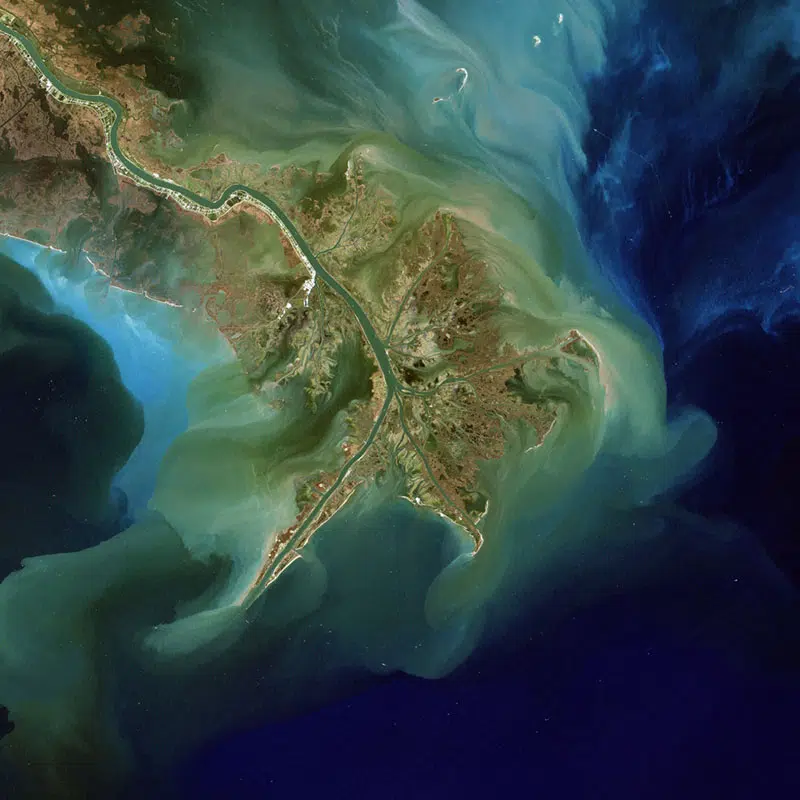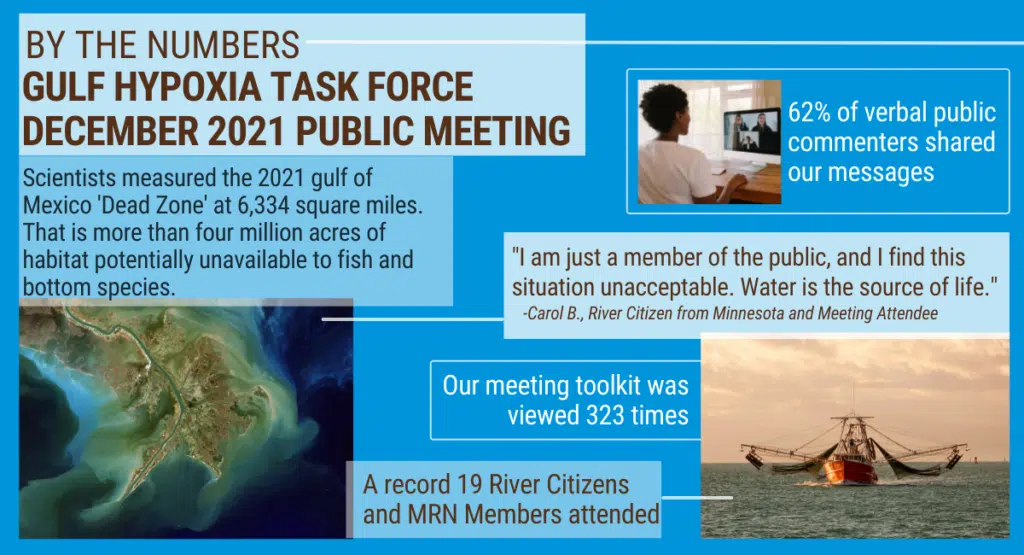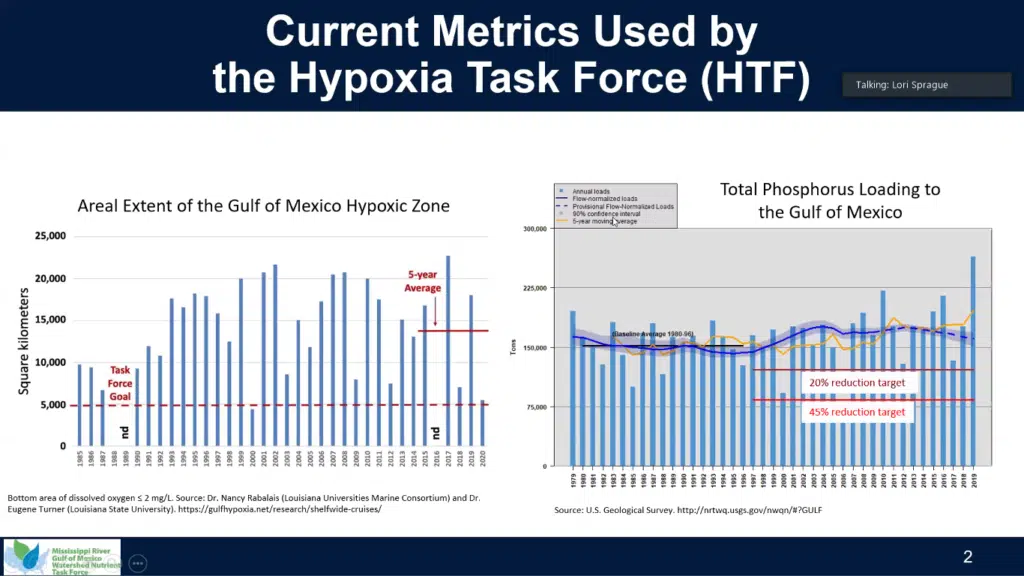Three Takeaways from Gulf Hypoxia Task Force Meeting
A record number of Mississippi River Network (MRN) members and River Citizens (like you!) attended the December 2021 virtual public meeting of the Gulf Hypoxia Task Force. What is the Gulf Hypoxia Task Force, and why was the recent public meeting very important? Read on!
What is the Gulf Hypoxia Task Force?
Have you heard of harmful algal blooms closing beaches or lakes in your state? Maybe you’ve read about fisheries in the Gulf Coast impacted by “red tides” or the Gulf Dead Zone. These are all examples of nutrient pollution – pollution caused by excess Nitrogen and Phosphorus in our Mississippi River system.
 The Gulf Hypoxia Task Force (GHTF) is the only group formally tasked with and responsible for specific goals to reduce nutrient pollution in the Mississippi River basin. This Task Force consists of representatives from 12 states, five federal agencies, and one representative for tribes. (See the list of current members here.)
The Gulf Hypoxia Task Force (GHTF) is the only group formally tasked with and responsible for specific goals to reduce nutrient pollution in the Mississippi River basin. This Task Force consists of representatives from 12 states, five federal agencies, and one representative for tribes. (See the list of current members here.)
While there are no non-profit, grassroots, or community groups formally appointed to the GHTF, the Task Force hosts one public meeting every year with an opportunity for public engagement. In the past, this public attendance has been low. Often, the public attendees and commenters are from environmental non-profit organizations (like the Mississippi River Network).

What are the 2021 GHTF Public Meeting takeaways?
Here are our three key takeaways from the Gulf Hypoxia Task Force’s 2021 Public meeting:
- The EPA will outline its approach to nutrient pollution in a new memo this year.
- There will be “New Metrics” to complement existing metrics for the GHTF.
- More public and MRN member organizations participated in this GHTF public meeting than in past years.
1. The EPA will outline its approach to nutrient pollution in a new memo this year.
The recent event was the first GHTF meeting of the Biden Administration’s Environmental Protection Agency (EPA). It was an opportunity for us to learn about what this EPA will focus on and prioritize in terms of nutrient pollution reduction strategies.
We learned that the EPA will issue a new “Nutrients Memo” in the first quarter of 2022. EPA’s Senate-confirmed Assistant Administrator for Water, Radhika Fox, shared a few themes that will be in this memo: engaging the agriculture community, harmonizing EPA’s work with U.S. Department of Agriculture, deepening on-the-ground collaboration, and using the existing regulatory framework of the Clean Water Act to work on nutrient pollution.
“Despite progress and innovation with state programs…the Task Force is nowhere near achieving either of its overarching goals. We need to be doing much more to address nutrient pollution in the Mississippi River system”
–Maisah Khan, Policy Director, Mississippi River Network
2. There will be “New Metrics” to complement existing metrics for the GHTF.
The GHTF is considering a set of “New Metrics to complement the current metrics” including tracking water quality trends in the Mississippi River Basin. We’re excited that the National Great Rivers Research & Education Center (NGRREC) — an MRN member organization — is working with the Task Force on this new trends analysis.
The Task Force currently has two specific goals: 1) An interim target of reducing nitrogen and phosphorus loading to the Gulf by 20 percent by the year 2025 and an ultimate target of reducing 45 percent by 2035, and 2) reducing the average annual size of the Hypoxic Zone of 5,000 square kilometers by the year 2035. The slide below was presented during the public meeting and illustrated the Task Force’s current progress on the existing metrics.
The dotted red line on the left and the two red lines on the right represent the Task Force’s goals and reduction targets. Despite progress and innovation with state programs, these images illustrate how the Task Force is nowhere near achieving either of its overarching goals. We need to be doing much more to address nutrient pollution in the Mississippi River system.
3. More public and MRN member organizations participated in this GHTF public meeting than in past years.
We observed an increase in public participation compared to the last few years of GHTF meetings. Nearly 20 people from MRN member organizations or River Citizens attended this public meeting. Two River Citizens made their voices heard by making a live public comment about why they care about the Mississippi River and how nutrient pollution impacts their day-to-day lives. Most public commenters (verbal and written) carried our shared messages about needing to do more to protect our rivers and water quality by increasing action on nutrient pollution.
“I am just a member of the public, and I find this situation unacceptable. Water is the source of life.”
-Carol B., River Citizen from Minnesota
If you missed the meeting and want to take a deeper dive into the information, you can view presentation slides and public comments on the EPA’s meeting webpage here: https://water-meetings.tetratech.com/Hypoxia/StaticPublic/materialstf.htm
What’s next and where can I learn more?
After the meeting, MRN invited our member organizations and River Citizens to debrief and discuss the next steps from our shared experience at the Task Force meeting.
Whether it was the American Farmland Trust sharing their interest in encouraging more media and press to report on this issue or the Illinois Stewardship Alliance sharing plans for Soil Health Week, we are looking forward to sharing more opportunities for River Citizens to engage on this issue in 2022.
If you aren’t already, make sure that you are a River Citizen to receive information about upcoming events and opportunities to act!
Learn more about nutrient pollution
- What is nutrient pollution? https://1mississippi.org/nutrient-pollution/
- What is the Dead Zone? https://www.healthygulf.org/our-work/protecting-water-2/the-dead-zone
- General info about the Gulf Hypoxia Task Force, members, history, and past documents: https://www.epa.gov/ms-htf
- View presentations and read public comments made at the 2021 GHTF public meeting https://water-meetings.tetratech.com/Hypoxia/StaticPublic/materialstf.htm
Learn more about Mississippi River states & Issues impacting River Citizens
- Thoughts about Iowa’s Nutrient Reduction Strategy from the IA Environmental Council: https://www.iaenvironment.org/newsroom/water-and-land-news/what-if-the-nrs-actually-reduced-nutrient-pollution-iec-releases-nrs-20-policy-recommendations
- Nutrient pollution impacts on Iowa’s drinking water and recreational water: https://www.iaenvironment.org/news-resources/fact-sheets/water-and-land-fact-sheets
- Chicago Tribune Article on Illinois’ Nutrient Reduction Strategy https://www.chicagotribune.com/news/environment/ct-nutrient-pollution-illinois-algae-20211221-uz3p3f6dxrcjzls6ofzfprdkny-story.html
- Missouri and nitrates in private well water https://moenvironment.org/well-water-contamination/
- Harmful Algal Blooms and pets https://coastalscience.noaa.gov/news/protecting-your-dog-from-harmful-algal-blooms-information-and-resources/
Join our
COMMUNITY
And Get a Free E-book!
When you sign up as a River Citizen you’ll receive our newsletters and updates, which offer events, activities, and actions you can take to help protect the Mississippi River.
You’ll also get our free e-book, Scenes From Our Mighty Mississippi, an inspiring collection of images featuring the River.
Step 1
Become a River Citizen
Yes! The River can count on me!
I am committed to protecting the Mississippi River. Please keep me informed about actions I can take to protect the Mississippi River as a River Citizen, and send me my free e-book!, Scenes From Our Mighty Mississippi!
Step 2
LEARN ABOUT THE RIVER
We protect what we know and love. As a River Citizen, you’ll receive our email newsletter and updates, which offer countless ways to engage with and learn more about the River. You can also follow us on Instagram, Facebook, X (Twitter) , and YouTube, where we share about urgent issues facing the River, such as nutrient pollution, the importance of floodplains and wetlands, and bedrock legislation such as Farm Bill Conservation Programs.
Step 3
Take Action
There are many ways you can jump in and take action for a healthy Mississippi River. Our 10 actions list includes simple steps you can take at any time and wherever you are. Check out our action center for current action alerts, bigger projects we are working on, and ways to get involved.


